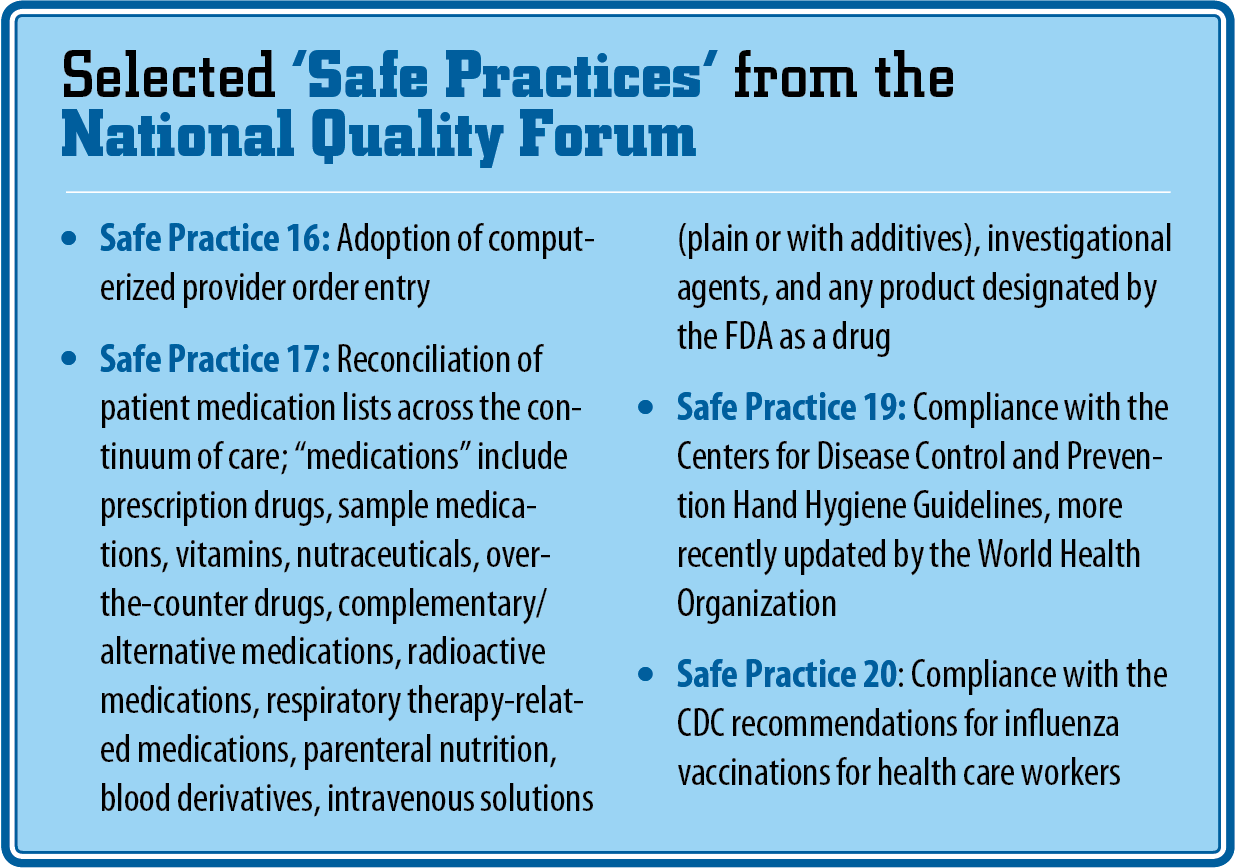Article
How to prevent medication errors in your practice
In this article, Robert A. Dowling, MD, discusses additional opportunities for urologists to improve the safety of care in their own practices in the context of the NQF best practices.

Dr. DowlingIn my last two Bottom Line articles, I discussed the most recent “safe practices” recommendations of the National Quality Forum (NQF) that are relevant to independent urology practices. Creating and measuring a culture of safety is the first step in a quality management program, followed by identifying and mitigating risks and hazards in the health care setting. Implementation of a robust informed consent process, transparency in disclosing errors, ensuring the competency of staff and caregivers, and a standard labeling policy are additional components of a safe office environment.
In this article, I will discuss additional opportunities for urologists to improve the safety of care in their own practices in the context of the NQF best practices.
Adoption of CPOE
The ordering, administration, and documentation of medications is paramount to patient safety and often at the center of issues with adoption of health information technology (including “meaningful use”). NQF Safe Practice 16 calls for the adoption of computerized provider order entry (CPOE). In its most mature form, this includes integration with error prevention software, clinical decision-making tools (interaction, allergy, duplication, and disease interaction checking at a minimum), dosage adjustment based on labs and other clinical information, and integration with pharmacy dispensing solutions.
CPOE and accompanying clinical decision support (CDS) have been demonstrated to prevent medication errors, although the ability to prevent harm to patients is still a matter of conflicting research, according to the Agency for Healthcare Research & Quality’s 2009 publication, “Clinical Decision Support Systems: State of the Art.”
NEXT: Barriers to safe and effective CPOE adoption
More from Dr. Dowling
True informed consent bolsters patient safety
How to evaluate patient safety in your practice
Telemedicine: Are we reaching a tipping point?
Safe and effective CPOE adoption still faces barriers in urology offices, including considerable variation in the function of electronic health record CPOE modules, change management issues, alert fatigue (when coupled with CDS), and confusion about the ability or role of non-licensed providers (such as medical assistants) to enter medication orders. (The Centers for Medicare & Medicaid Services recently clarified that the “meaningful use” Stage 2 objectives require that a non-licensed provider be credentialed by someone other than her employer in order to be considered eligible to use CPOE.) Even practices that choose not to participate in meaningful use should establish and adopt personnel and procedural standards in their office for medication ordering.
NEXT: Reconciliation of patient medication lists

Reconciliation of patient medication lists
Safe Practice 17 calls for the reconciliation of patient medication lists across the continuum of care, and includes in its definition of “medication” prescription medications, sample medications, vitamins, nutraceuticals, over-the-counter drugs, complementary and alternative medications, radioactive medications, respiratory therapy-related medications, parenteral nutrition, blood derivatives, intravenous solutions (plain or with additives), investigational agents, and any product designated by the FDA as a drug.
READ: Patient portal efforts don’t end with implementation
Medication reconciliation in a clinical information system may be viewed as a time-consuming clerical task, but in reality forms the basis for safe provider prescribing and clinical decision support. Practices should consider formal training of personnel (including physicians) who perform this important task in order to achieve efficiencies and prevent errors.
One example of a common workflow that contributes to and perpetuates inaccurate medication lists is an intake question like, “Are you still on all the same medications as last year” followed by “medications reviewed.” Best practices would include a line-by-line review of each medication at each encounter with the patient, entering stop dates for important medications, and engaging patients in maintaining their own lists.
The AHRQ report, “Creating an accurate medication list in the outpatient setting through a patient-centered approach,” concluded: “Patient-centered care strategies, applied at the community level, are associated with significant improvement in the accuracy of the medication list in the outpatient setting."
NEXT: Preventing transmission of infections
Preventing transmission of infections
Two other safe practices concern the importance of reducing the transmission of infections from care settings to patients. Safe Practice 19 calls for compliance with the Centers for Disease Control and Prevention Hand Hygiene Guidelines, more recently updated by the World Health Organization. All health care workers should be familiar with these guidelines, and practices should consider including these practices in their competency training and periodic assessment.
Safe Practice 20 calls for compliance with the CDC recommendations for influenza vaccinations for health care workers, which are updated each year. While many urologists practicing in hospitals are required to conform to flu vaccination policies to maintain their privileges, the same requirements are not always imposed on their office staff. Best practices in this area include implementing a formal staff policy, continuous education, offering the vaccine at no cost in the office, and maintaining accurate records.
Bottom line: Health care delivery in an office setting is an error-prone activity, but many of the errors that threaten the safety of patients have been studied and are preventable. These recognized, evidence-based safe practices can be implemented or refined by the practicing urologist at very little cost.
NEXT: Recommended reading
Recommended reading
“Clinical Decision Support Systems: State of the Art” (Agency for Healthcare Research & Quality)
Have you read:
PCa surveillance: Impact on pay may surprise you
Could your EHR system put patients at risk?
EHR difficulty? Solution may lie within work flow
Subscribe to Urology Times to get monthly news from the leading news source for urologists.
Newsletter
Stay current with the latest urology news and practice-changing insights — sign up now for the essential updates every urologist needs.

















